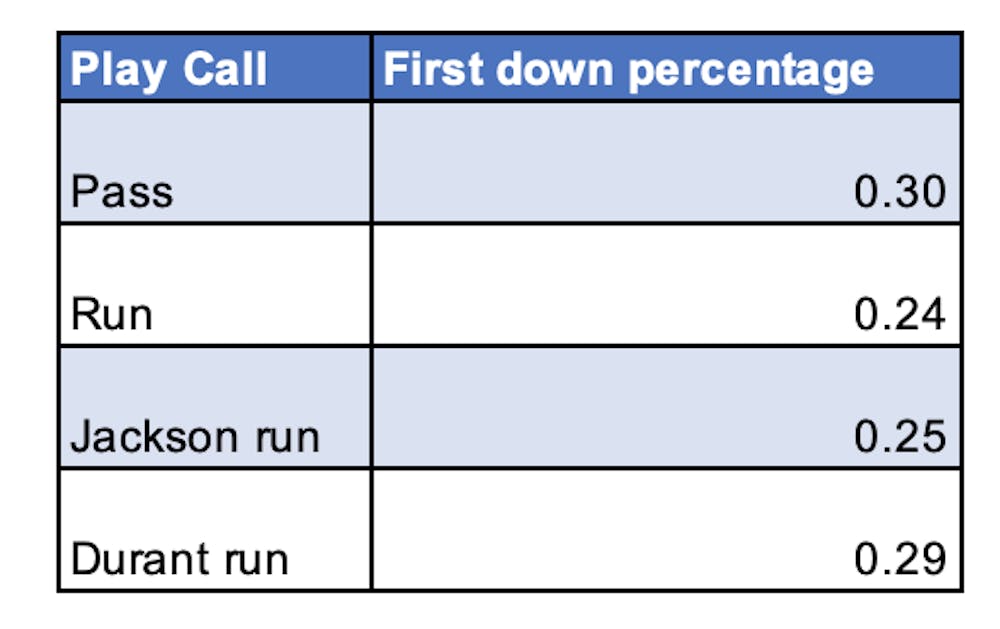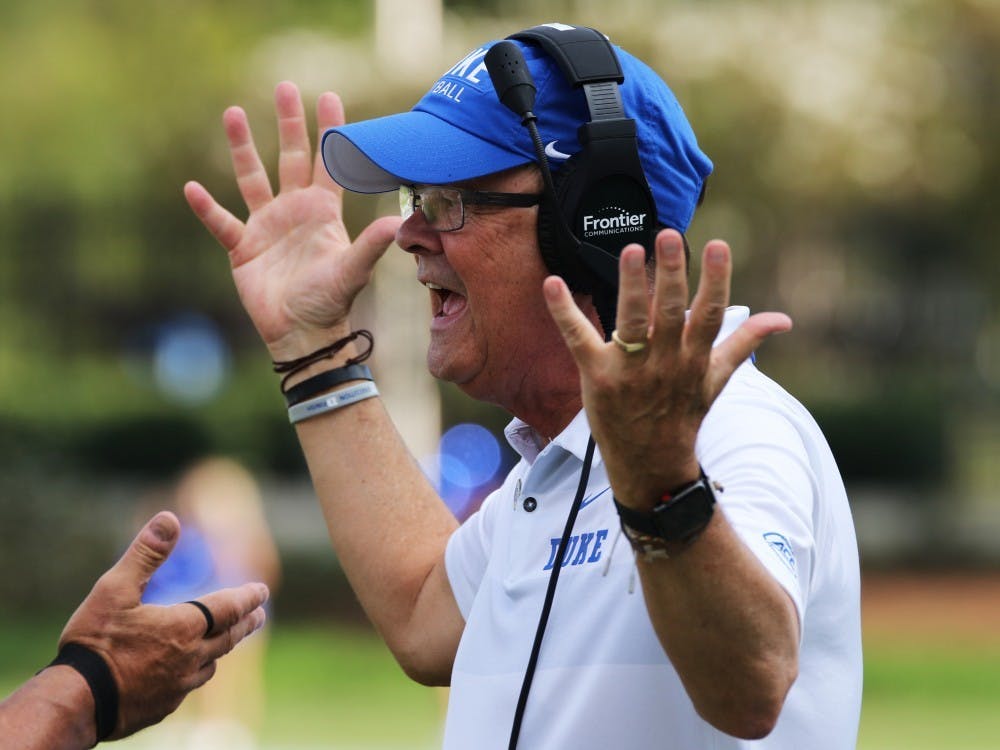Heading into this season, there was as much reason for optimism on the offensive side of the ball for Duke as ever.
With widely-regarded offensive genius David Cutcliffe taking over play-calling duties, a highly-recruited quarterback in Clemson transfer Chase Brice and explosive, experienced veteran skill position players like Deon Jackson and Noah Gray, the 2020 Blue Devil offense was as good on paper as maybe any offense in recent program history.
Through the team’s first four games, however, the offense was a complete bust, turning the ball over 15 times and putting up a measly 17.5 points per game as the Blue Devils limped to an 0-4 record. This past Saturday’s win against Syracuse seemed to be a major sign of improvement for the team, as Duke dominated offensively to the tune of 38 points and 645 total yards, both marks easily surpassing the previous single-game highs for the season.
But even after the onslaught of the Orange, the Blue Devils still rank 63rd of 76 qualifying teams in points per game, and have punted as much as nearly anyone else.
So, what has gone wrong with the Blue Devil offense so far? I dug beyond the basic box score to find some answers, charting all 395 offensive plays that Duke has run this season. Here’s what I learned:
Cutcliffe is in love with the run
In order to examine how Cutcliffe has behaved as Duke’s play caller, we must first contextualize the data. Available historical data for football situation play calling is sparse for college football, so for the purpose of this exercise I will be comparing Duke’s 2020 data to the dataset containing all play calls in the NFL from 2009 to 2018 from this Northwestern study on NFL tendency analysis.
When it comes to play calling, the most important, basic decision for any offense is whether to run or pass the ball. As anyone who is familiar with football analytics would tell you, pass plays are simply more valuable for any offense. Just look at the consistently high-powered offenses of current Mississippi State head coach Mike Leach, preacher of the legendary Air Raid system.
According to the Northwestern data, NFL teams pass 49 percent of the time on first down, 58 percent of the time on second down, 79 percent of the time on third down and 64 percent of the time on fourth down. To clarify, this NFL data by no means represent what is optimal to score the most points—the roughly even run/pass split on first downs is anything but optimal, as the numbers suggest teams should be passing much more frequently on first down. Still, this allows us to look at how Cutcliffe is behaving with much-needed context.
Without further ado, let’s take a look at how Duke stacks up.

The most glaring takeaway here is that the Blue Devils are rushing way more than expected (or they probably should). Cutcliffe is calling runs seven percent more than average on second down and 13 percent more than average on third down. This includes a 39 percent rush percentage on second-and-long (defined as six or more yards needed for the first down). Basic logic should tell you this number is way too high, and a Yahoo! Sports analysis illustrates that by calling a run play on second-and-long, you are losing up to .2 Expected Points Added per play.
What gets first downs for the 2020 Blue Devils?
Don’t be fooled by the gaudy rushing numbers Duke put up against Syracuse: pass plays are still more efficient for this team. Even though the Blue Devils have allowed the second-most sacks and thrown the second-most interceptions in all of college football, dropbacks have still been far more valuable for the Duke offense than runs. Pass plays result in a Blue Devil first down 30 percent of the time this season, while run plays result in a Blue Devil first down 24 percent of the time.

I included the running back first down percentage there, as second-string running back Mataeo Durant has passed the eye test compared to Jackson this season. The underlying numbers support this assessment, albeit in a small sample size (Durant has 52 carries compared to Jackson’s 89).
Who is getting it done through the air?
I’ll save you from further droning on the superiority of the pass, and now let’s see who on Duke’s roster is actually making these plays more valuable. Eleven pass catchers have received five or more targets, and here are their average yards gained per target.

In limited work, redshirt sophomore Jarett Garner has popped off the screen when watching the Blue Devils this season, and boy does the data back this up. Garner has gained more than twice as many yards per target as all but one Blue Devil pass catcher, and an incredible seven of his 11 targets have resulted in first downs.
On the flip side, Jackson’s 1.8 yards per target mark is an eye sore. Many of Jackson’s targets have been desperate checkdowns from Brice, but it’s clear that putting the ball in Jackson’s hands has not been a positive thing much of the time for the Duke offense.
Diagnosis
As I expected, Cutcliffe has been all too reliant on the run this fall. Now, this sort of approach made sense when Quentin Harris, a capable runner with little pedigree, was the Blue Devil starting quarterback in 2019, but it simply is baffling with Brice, a below-average runner with superior arm talent, under center.
Unfortunately for the Blue Devil offense, I believe confirmation bias will prevent Cutcliffe from trusting Brice more. Against Syracuse, Cutcliffe called nearly twice as many runs as passes. Though that might have worked against the Orange’s dreadful interior, it is not a recipe for success against most opponents.
I can’t imagine Duke will continue to turn the ball over or allow sacks at its current historic pace. Even a slight improvement in pass protection and ball security would suffice to further expand the gap between the value of pass and run plays. If Cutcliffe wants to turn this 2020 season around, he needs to go against his gut and embrace the pass.
Get The Chronicle straight to your inbox
Signup for our weekly newsletter. Cancel at any time.

